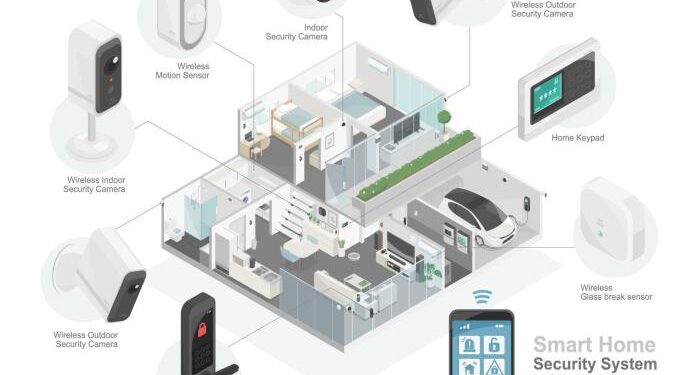Embarking on the journey of smart security system installation opens up a realm of possibilities for safeguarding your home in the digital age. From cutting-edge technology to seamless integration, this guide dives deep into the world of smart security systems, offering insights that will revolutionize the way you think about home security.
Introduction to Smart Security System Installation
In today's fast-paced world, ensuring the safety and security of our homes is a top priority. This is where smart security systems come into play, offering advanced features and technology to protect your property and loved ones.
Smart security systems utilize interconnected devices such as cameras, sensors, and alarms to monitor and protect your home from potential threats. These systems can be controlled remotely via smartphones or tablets, providing homeowners with real-time updates and peace of mind.
Benefits of Installing a Smart Security System
- Enhanced Security Measures: Smart security systems offer 24/7 monitoring and instant alerts in case of any suspicious activity, providing a higher level of security compared to traditional systems.
- Remote Access and Control: With smart security systems, homeowners can monitor their property from anywhere in the world, allowing them to check in on their home even when they are away.
- Integration with Smart Home Devices: Many smart security systems can be integrated with other smart home devices such as smart lights, locks, and thermostats, creating a seamless and interconnected home automation system.
Popular Smart Security System Brands
- Ring: Known for their video doorbells and security cameras, Ring offers a range of smart security products that are easy to install and use.
- Nest Secure: Nest Secure provides a comprehensive home security system with features like motion detection, remote arming/disarming, and mobile alerts.
- ADT Pulse: A trusted name in home security, ADT Pulse offers smart security solutions with professional monitoring services for added peace of mind.
Planning for Installation
When it comes to installing a smart security system in your home, proper planning is essential to ensure a smooth and successful setup. This involves considering various factors and making decisions that will impact the effectiveness of your security system.
Key Factors to Consider
- Security Needs: Evaluate the specific security needs of your home, such as the size of the property, the number of entry points, and any vulnerable areas that require monitoring.
- Budget: Determine your budget for the smart security system, including the cost of equipment, installation, and any ongoing monitoring fees.
- Integration: Consider whether you want a standalone security system or one that can be integrated with other smart devices in your home, such as smart lights or locks.
- Remote Access: Decide if you want the ability to monitor and control your security system remotely via a mobile app or online portal.
- Professional Installation: Determine if you prefer professional installation or if you are comfortable installing the system yourself.
Wired vs. Wireless Systems
When choosing a smart security system, one important decision to make is whether to opt for a wired or wireless system. Each type has its own set of advantages and installation requirements.
| Wired Systems |
Wireless Systems |
| Require cables for connection, which may involve drilling holes for installation. |
Easy to install without the need for extensive wiring, making them ideal for rental properties. |
| Tend to be more reliable and less susceptible to interference
. |
May experience signal interference from other wireless devices or obstacles within the home. |
| Often have higher upfront costs due to the need for professional installation. |
Generally more cost-effective and easier to expand or relocate as needed. |
Installation Process
Installing a smart security system involves a series of steps to ensure proper functioning and maximum coverage for your home or business.
Tools and Equipment Needed
- Smart security system kit (cameras, sensors, control panel, etc.)
- Drill and screws for mounting cameras and sensors
- Cables for connecting components
- Smartphone or computer for system setup
- Ladder for reaching high installation points
Tips for Positioning Components
- Place cameras at entry points such as doors and windows for optimal coverage.
- Install motion sensors in areas with high foot traffic to detect movement effectively.
- Position the control panel in a central location for easy access and monitoring.
- Avoid placing cameras or sensors near sources of interference like bright lights or reflective surfaces.
Integrating Smart Devices
Integrating smart security systems with other smart home devices such as lights, locks, and thermostats can significantly enhance the overall security of your home. By connecting these devices, you can create a seamless and automated system that works together to keep your home safe and secure.
Benefits of Fully Integrated Smart Home System
Having a fully integrated smart home system offers several benefits when it comes to enhancing security:
- Remote Access: You can monitor and control your security system and other devices from anywhere using your smartphone or tablet.
- Automation: Create custom automation routines that coordinate the actions of different devices to enhance security measures.
- Enhanced Alerts: Receive notifications on your phone in real-time when any unusual activity is detected, allowing for immediate action.
- Increased Deterrence: The presence of interconnected devices can deter potential intruders and enhance the overall security of your home.
Automation Routines for Security
Here are some examples of automation routines that can be created with interconnected smart devices for security purposes:
- When the smart security system detects motion at the front door, the lights automatically turn on to deter intruders.
- If a window sensor is triggered, the thermostat can be set to turn off to prevent an intruder from entering unnoticed.
- When the security system is armed at night, all smart locks automatically engage to secure the entire house.
End of Discussion
In conclusion, smart security system installation is not just about protection; it's about peace of mind and convenience. By embracing the latest innovations in home security, you can create a safe haven that adapts to your lifestyle and enhances your overall quality of life.
Stay informed, stay secure, and stay ahead with smart security systems.
FAQ Resource
What are the benefits of a smart security system over traditional ones?
Smart security systems offer remote access, real-time alerts, and integration with other smart devices for a comprehensive home security solution.
What factors should be considered when selecting a smart security system?
Consider features like video quality, motion detection, ease of installation, and compatibility with existing smart home devices.
How can smart security systems be integrated with other smart devices?
Smart security systems can be linked to smart lights, locks, and thermostats through a central hub or app, allowing for seamless automation and control.














